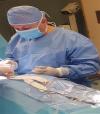What Causes Numbness In Right Arm, Blurred Vision, Fluent Aphasia And Reading Disability?

Posted on
Sun, 1 May 2016
Medically reviewed by
Ask A Doctor - 24x7 Medical Review Team
 Sun, 1 May 2016
Answered on
Sun, 1 May 2016
Answered on
 Thu, 16 Jun 2016
Last reviewed on
Thu, 16 Jun 2016
Last reviewed on
Question : I have a question relating to events that happen to someone I know.
I am interested in the areas of the brain that were affected. These where the symptoms
- Numbness in her right arm
- Right arm slumped across desk chair
- blurred vision
- mild fluent aphasia
- Increased temperature – 38*C
- Unable to repeat words correctly
- Minor reading and reading impairment
- Difficulty in seeing objects on patients right side
- Slightly increased tone in right arm
- Mildly increased reflexes in right arm, Babinski sign present
- Decreased pinprick sensation on right side
- Agraphesthesia and astereognosis in right arm
I am interested in the areas of the brain that were affected. These where the symptoms
- Numbness in her right arm
- Right arm slumped across desk chair
- blurred vision
- mild fluent aphasia
- Increased temperature – 38*C
- Unable to repeat words correctly
- Minor reading and reading impairment
- Difficulty in seeing objects on patients right side
- Slightly increased tone in right arm
- Mildly increased reflexes in right arm, Babinski sign present
- Decreased pinprick sensation on right side
- Agraphesthesia and astereognosis in right arm
Brief Answer:
Left parietal lobe impairment.
Detailed Answer:
Hello and thanks for using HCM.
I have read your question and understand your concerns.
Those symptoms indicate that the left parietal lobe of the brain is dysfunctional.
It could be affected by mass lesions, arteriovenous malformation, stroke, and since there is temperature, brain abscess.
The diagnosis depends on the symptoms onset (gradual or abrupt), duration, and in brain imaging studies.
Hope you found the answer helpful.
Let me know if I can assist you further.
Greetings.
Left parietal lobe impairment.
Detailed Answer:
Hello and thanks for using HCM.
I have read your question and understand your concerns.
Those symptoms indicate that the left parietal lobe of the brain is dysfunctional.
It could be affected by mass lesions, arteriovenous malformation, stroke, and since there is temperature, brain abscess.
The diagnosis depends on the symptoms onset (gradual or abrupt), duration, and in brain imaging studies.
Hope you found the answer helpful.
Let me know if I can assist you further.
Greetings.
Above answer was peer-reviewed by :
Dr. Sonia Raina


Symptoms were abrupt. I was just curious as to if all the symptoms are related to a lesion in the primary somatosensory cortex or if any other regions of the brain are affected. I dont understand how the mildly increased reflexes in right arm, Babinski sign present, and slightly increased tone in right arm fit in.
like, if there was a lesion, where would the lesion be?
like, if there was a lesion, where would the lesion be?
Brief Answer:
Mixed signs due to mass effect.
Detailed Answer:
Hello and thanks for being on follow up.
Babinski sign or reflex indicates upper motor neuron involvement and is not characteristic for abrupt start of symptoms.
It may have been there from other reasons such cervical cord myelomalacia for example.
If days after abrupt start of symptoms passed, Babinski sign may become positive together with increased levels.
It may be related to motor pathways dysfunction due to mass effect, edema etc.
The lesion in this case is located more probably at parietal lobe and additional motor signs may be related to compression of nearby motor areas by edema for example.
Abrupt onset is typical for stroke, arteriovenous malformation rupture, trauma.
Hope I helped you.
Take care.
Mixed signs due to mass effect.
Detailed Answer:
Hello and thanks for being on follow up.
Babinski sign or reflex indicates upper motor neuron involvement and is not characteristic for abrupt start of symptoms.
It may have been there from other reasons such cervical cord myelomalacia for example.
If days after abrupt start of symptoms passed, Babinski sign may become positive together with increased levels.
It may be related to motor pathways dysfunction due to mass effect, edema etc.
The lesion in this case is located more probably at parietal lobe and additional motor signs may be related to compression of nearby motor areas by edema for example.
Abrupt onset is typical for stroke, arteriovenous malformation rupture, trauma.
Hope I helped you.
Take care.
Above answer was peer-reviewed by :
Dr. Sonia Raina

Answered by

Get personalised answers from verified doctor in minutes across 80+ specialties



